UPSC Daily Current Affairs: 7th October 2024 | Current Affairs & Hindu Analysis: Daily, Weekly & Monthly PDF Download
GS3/Science and Technology
Respiratory Synctial Virus Infection
Source: Frontiers
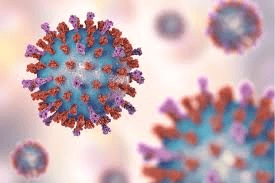
Why in news?
Recently, the World Health Organization recommended vaccinating pregnant women and administering infants with an antibody to prevent severe Respiratory Synctial Virus (RSV) infection in newborns.
About Respiratory Synctial Virus Infection:
- RSV is a virus that primarily leads to cold-like symptoms but is a significant cause of severe infections and fatalities among infants and older adults.
Symptoms:
- Common symptoms include a runny nose, loss of appetite, coughing, and more.
Transmission:
- RSV is transmitted through the air when infected individuals cough or sneeze.
- Direct contact with an infected person, such as kissing a child's face, can also spread the virus.
- Touching surfaces or objects contaminated with the virus and subsequently touching one's face can lead to infection.
Individuals at High Risk:
- Premature infants and babies under six months are at greater risk of severe illness.
- Adults over 65 and those with weakened immune systems, chronic lung diseases, or congenital heart conditions are also vulnerable to serious RSV cases.
Contagious Period:
- People infected with RSV are typically contagious for 3 to 8 days, but infants and immunocompromised individuals may spread the virus for up to 4 weeks.
Severe Outcomes:
- Severe RSV infections can lead to serious conditions like pneumonia and bronchiolitis.
GS3/Environment
EnviStats India 2024
Source: New Indian Express
Why in news?
The Ministry of Statistics and Programme Implementation (MoSPI) has unveiled the "EnviStats India 2024: Environment Accounts" Report.
- The EnviStats India 2024 Report is the seventh consecutive publication from MoSPI. It compiles environmental-economic accounts informed by the System of Environmental-Economic Accounting (SEEA) Framework. This framework serves as a global benchmark for merging environmental data with economic statistics, providing valuable insights into the country’s natural resources, ecosystems, and efforts in environmental sustainability.
Key Highlights:
- Protected Areas (SDG 13 & SDG 15)
- A notable 72% increase in the number of Protected Areas from 2000 to 2023.
- A 16% rise in the area designated as Protected Areas, demonstrating efforts towards biodiversity conservation.
- Mangrove Cover
- An 8% increase in mangrove cover between 2013 and 2021, showcasing positive trends in coastal ecosystem protection.
- Ocean Accounts (SDG 14: Life below Water)
- Introduced for the first time, these accounts detail the extent and condition of ocean ecosystems.
- Energy Use & Physical Asset Accounts (SDG 7: Affordable and Clean Energy & SDG 13: Climate Action)
- Includes Physical Asset Accounts and Physical Supply and Use Tables for Energy, aligned with the SEEA-Energy Framework, utilizing data from ministries such as Coal and Petroleum.
- Soil Nutrient Index (SDG 2: Zero Hunger)
- Updated Soil Nutrient Index data based on the Soil Health Card 2023-24, reflecting on soil health and agricultural sustainability.
- Biodiversity & Species Richness (SDG 15: Life on Land)
- Provides data on both faunal and floral diversity, including endangered species like Leopards and Snow Leopards, highlighting the necessity of biodiversity conservation.
Policy Recommendations
The EnviStats India 2024 Report proposes several policy directions based on its findings:
- Biodiversity Protection
- Emphasize community-led conservation initiatives and enhance the protection of critical ecosystems.
- Ocean Ecosystem Management
- Utilize Ocean Accounts to ensure sustainable management of marine resources and to address pollution control.
- Soil Management Practices
- Encourage sustainable farming methods and improved soil management, leveraging Soil Health Cards to boost productivity.
- Integrated Planning
- Prioritize conservation of species, restoration of habitats, and genetic conservation through data-driven planning.
GS3/Science and Technology
Emergency Use Listing
Source: The Hindu
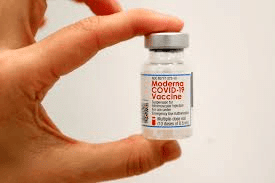
Why in News?
The World Health Organization (WHO) recently announced its first Emergency Use Listing (EUL) for an In Vitro Diagnostic (IVD) test for mpox. This development is significant in the context of public health emergencies, as it allows for quicker access to critical diagnostic tools.
About Emergency Use Listing:
- The EUL procedure is a risk-based approach designed to assess and approve unlicensed vaccines, therapeutics, and IVDs.
- This process aims to accelerate the availability of these medical products to those affected by a public health crisis.
- It helps UN procurement agencies and Member States evaluate the acceptability of specific products, based on essential quality, safety, efficacy, and performance data.
Criteria for products listing under EUL:
- The intended disease is serious or life-threatening and has the potential to cause an outbreak, epidemic, or pandemic.
- Current available products have not been effective in controlling or preventing the disease.
- The product must be manufactured in line with Good Manufacturing Practices (GMP) for medicines and vaccines, and under a functional Quality Management System (QMS) for IVDs.
GS3/Health
World Cerebral Palsy Day
Source: AIR

Why in news?
The World Cerebral Palsy Day was celebrated on October 6 with the theme ‘#UniquelyCP’. This event highlights the individuality of those living with cerebral palsy, stressing that their identity extends beyond their disability.
About
- Condition: A collection of neurological disorders that influence movement, muscle tone, and posture.
- Cause: Primarily linked to abnormal brain development, which usually occurs before birth; it may also result from injuries during birth or in early childhood.
- Types:
- Spastic CP: Characterized by stiff muscles and challenges with movement, this is the most prevalent type, accounting for 70-80% of cases.
- Dyskinetic CP: Involves uncontrollable movements that impact the limbs.
- Ataxic CP: Results in poor balance and coordination.
- Mixed CP: Displays symptoms from various types.
- Symptoms
- Challenges with motor skills, such as crawling and walking.
- Muscle stiffness or looseness.
- Poor coordination and balance.
- Speech or swallowing difficulties.
- Seizures may occur in some individuals.
- Diagnosis
- Diagnosis typically involves a physical examination, MRI scans, and developmental monitoring, usually identified within the first two years of life.
- Risk Factors
- Premature birth.
- Low birth weight.
- Multiple births.
- Maternal infections during pregnancy.
- Lack of oxygen at birth.
- Treatment
- Includes physical, occupational, and speech therapy.
- Medications may be prescribed to alleviate muscle stiffness.
- Surgery may be necessary in severe cases.
- Life Expectancy
- Individuals can have a normal life expectancy, influenced by the severity of their condition and any associated complications.
- Prevention
- While some causes can be prevented with appropriate maternal care, many factors cannot be controlled.
- Policy Support
- Niramaya Health Insurance Scheme:
- Coverage: Up to ₹1,00,000 for treatments, surgeries, and therapies for individuals with disabilities.
- Eligibility: Available for those with Autism, Cerebral Palsy, Mental Retardation, and Multiple Disabilities.
- Annual Renewal: Requires yearly renewal with varying fees for Below Poverty Line (BPL) and Above Poverty Line (APL) categories.
- Easy Application: Enrollment and claims can be processed online through Registered Organizations (ROs).
- Niramaya Health Insurance Scheme:
- PYQ:
- [2020] Discuss the necessity of robust and effective health care policies to enhance social development, particularly in the realms of geriatric and maternal health care.
GS3/Environment
Barnawapara Wildlife Sanctuary
Source: Deccan Chronicle
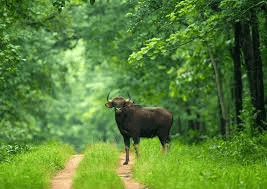
Why in News?
Two wild buffalo calves, recently born in Barnawapara Wildlife Sanctuary located in Chhattisgarh, have sparked renewed optimism for the conservation of this critically endangered species in the region.
About Barnawapara Wildlife Sanctuary:
- Location: Situated in the Raipur district of Chhattisgarh.
- Rivers: The sanctuary is flanked by the Balmedhi, Jonk, and Mahanadi rivers, which serve as crucial waterways for the ecosystem.
- Boundaries: The Balamdehi River delineates the western edge while the Jonk River marks the northeastern boundary of the sanctuary.
- Flora: The sanctuary is characterized by significant vegetation, including Teak, Sal, and a variety of mixed forests.
- Fauna: Wildlife commonly observed includes Cheetal, Sambhar, Nilgai, Wild Boar, Sloth Bear, and Wild Dog.
Key Facts about Indian Wild Buffalo:
- The Indian Wild Buffalo is recognized as the state animal of Chhattisgarh, being a substantial bovine species endemic to the Indian subcontinent and Southeast Asia.
- Habitat: Primarily inhabits alluvial grasslands, marshes, swamps, and river valleys.
- Concentration: In India, significant populations are found in northeastern regions, notably within Kaziranga National Park, Manas National Park, Dibru-Saikhowa National Park, Laokhowa Wildlife Sanctuary, and D’Ering Memorial Wildlife Sanctuary in Arunachal Pradesh.
Conservation Status:
- IUCN: Classified as Endangered.
- Legal Protection: Listed under Schedule 1 of the Wildlife (Protection) Act, 1972.
GS2/International Relations
Trade not just globalised but now weaponized
Source: Indian Express
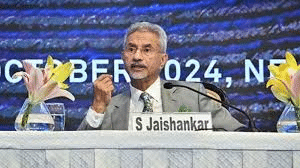
Why in News?
External Affairs Minister S. Jaishankar, during his address at the Kautilya Economic Conclave, discussed the growing backlash against globalisation that has emerged over the last 25 years. He pointed out that trade has evolved beyond mere globalisation to being weaponised, leading countries to regard economic transactions through the prism of national security. This shift has caused many nations, including India, to adopt protectionist measures, such as anti-dumping policies specifically aimed at Chinese products.
Weaponisation of Trade
- Weaponisation of trade refers to the strategic use of trade policies to compel other nations to alter their trading behaviors in line with specific political or economic objectives.
- Methods of weaponisation may include:
- Imposing trade embargoes against certain countries.
- Selectively restricting imports or exports.
- Threatening to utilize trade instruments as leverage.
- Capitalizing on a nation's economic dependency on another.
- This approach positions trade as a mechanism of foreign policy rather than solely an economic endeavor.
Not a New Concept
- The weaponisation of trade is not a recent phenomenon; trade embargoes and sanctions have been in practice for centuries.
- Historical examples include:
- The U.S. oil embargo against Japan in the 1930s, which some historians believe contributed to Japan's attack on Pearl Harbor.
- Economic sanctions on South Africa that played a role in dismantling apartheid.
Shift Towards Targeted Sanctions
- Recent years have seen a transition from broad embargoes to targeted sanctions aimed at specific individuals or companies.
- This trend began during the George W. Bush administration and has intensified since then.
- Current sanctions often focus on financial restrictions rather than outright trade bans, making it easier to implement sanctions.
China's Aggressive Use of Trade as a Weapon
- China has escalated the weaponisation of trade, showcasing actions such as:
- Reducing trade with Norway following the award of the Nobel Peace Prize to Liu Xiaobo in 2010.
- Limiting imports from Australia after it called for an inquiry into the origins of COVID-19.
- China employs trade as a tool for political influence, applying economic sanctions on nations that oppose its stance.
- Examples include:
- In 2021, Lithuania faced sanctions for hosting a Taiwanese Representative Office.
- Mongolia incurred punitive fees in 2016 for welcoming the Dalai Lama.
- In 2022, Taiwan experienced trade restrictions after a visit from U.S. House Speaker Nancy Pelosi, impacting imports of various goods.
China’s Control Over Critical Minerals
- In 2023, China imposed restrictions on the export of gallium and germanium, crucial for semiconductors and military technologies, as a response to U.S. restrictions on its access to advanced microprocessors.
- This move underscores China's strategic approach to using trade as a retaliatory tool against rival nations.
Push for De-dollarisation and Global Influence
- China is actively pursuing strategies to reduce reliance on the U.S. dollar in international trade, advocating for the global adoption of its currency, the renminbi yuan.
- This initiative aims to enhance China's economic clout and further its capacity to weaponise trade.
Steps Taken by Countries
- Global Pushback Against Coercion
- The Quad nations—India, Australia, Japan, and the U.S.—have publicly rejected coercive economic practices, affirming nations' rights to determine their own paths.
- G7 countries have echoed this stance, denouncing unilateral attempts to alter the status quo through force or coercion.
- Economic Diversification and Supply-Chain Resilience
- Establishing alternative supply chains is essential for countering trade weaponisation.
- An example is the Mineral Security Partnership (MSP), which includes 13 members such as India, the U.S., and the EU, aimed at ensuring the sustainable production and processing of critical minerals.
- Friend-shoring
- The concept of "friend-shoring," which involves confining supply chains to politically and economically allied nations, is becoming increasingly prevalent.
- Experts warn that this trend could disrupt global trade and weaken institutions like the WTO, ultimately diminishing the legitimacy of multilateral trade frameworks.
- Trade Protectionism
- The weaponisation of trade has prompted numerous countries, including India, to implement protectionist measures, such as anti-dumping duties targeting Chinese imports.
- For instance, India has enforced over 30 anti-dumping duties on Chinese products in 2024 alone.
- Concerns over job losses and the national security risks associated with technology have led nations to prioritize domestic industries over economic efficiency.
Rising Protectionism and Job Losses Amid Globalisation
- Jaishankar emphasized the social and political backlash against globalisation over the past 25 years.
- While globalisation has fostered deep interdependencies, it has also resulted in job losses and declining quality of life, influencing political dynamics in various regions.
- This dissatisfaction has fueled a rise in protectionist policies, as countries implement defensive measures against foreign imports.
- He reiterated that trade has evolved from merely being globalised to being weaponised.
- Concerns regarding job losses and national security risks linked to technology have shifted focus toward domestic priorities.
Shifted Focus in Global Politics: Conflicts Over Reforms
- Jaishankar noted that global conflicts, such as those in Ukraine and West Asia, have diverted attention from critical issues like the reform of Multilateral Development Banks (MDBs), climate change, and the India–Middle East–Europe Economic Corridor (IMEC).
- Despite these distractions, he assured that the IMEC, conceptualised during the G20 meeting, remains a viable initiative.
- India continues to engage in projects with the UAE and conducts feasibility studies with Saudi Arabia.
- The necessity for the IMEC has intensified due to rising geopolitical tensions, although its development has been impeded by current global conflicts.
GS3/Science and Technology
What is Progeria?
Source: News Medical

Why in News?
Sammy Basso, who was the longest-living survivor of the rare genetic disease progeria, recently died at the age of 28.
About Progeria:
- Progeria, formally known as Hutchinson-Gilford progeria syndrome, is an exceptionally rare genetic condition.
- This disorder leads to a rapid aging process in children.
- It originates from a minor genetic mutation.
- Progeria is estimated to affect 1 in every 4 million newborns globally.
- Infants with progeria may look healthy at birth, but they typically begin to exhibit signs of premature aging within their first one to two years.
- As the condition progresses, their growth rate diminishes, and they do not gain weight as anticipated.
- Importantly, progeria does not impact a child’s cognitive abilities or brain development.
Physical Characteristics Associated with Progeria:
- Hair loss, leading to baldness.
- Prominent and large eyes.
- Skin that appears aged and wrinkled.
- A thin, beaked nose structure.
- A face that is disproportionately small in comparison to head size.
- Decreased fat beneath the skin, resulting in a gaunt appearance.
Health Risks and Life Expectancy:
- As children with progeria mature, they develop health issues typically seen in older adults, such as:
- Bone density loss.
- Arterial hardening.
- Heart disease.
- The condition is invariably fatal, with heart complications or strokes being the primary causes of death in most afflicted children.
- The average lifespan for a child diagnosed with progeria is approximately 15 years, although some may live to around 20 years, while others may not survive into their teenage years.
Treatment Options:
- Currently, there is no cure for progeria.
- However, a medication known as lonafarnib has demonstrated the ability to slow the disease’s progression.
GS3/Environment
What are Eco-Sensitive Zones?
Source: Indian Express
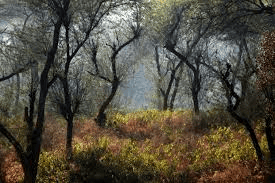
Why in News?
Many leaders from both the ruling BJP and opposition parties in Gujarat have voiced their objections to the proposed Eco-Sensitive Zones surrounding the Gir forest.
About Eco-Sensitive Zones:
- According to the National Wildlife Action Plan (2002-2016) from the Union Ministry of Environment, Forest and Climate Change, land within 10 kilometers of national parks and wildlife sanctuaries should be designated as eco-fragile zones or Eco-Sensitive Zones (ESZ).
- While the 10-kilometer guideline serves as a general rule, its application may differ depending on specific circumstances.
- The Union government can also declare areas beyond 10 kilometers as ESZs if they are part of significant ecological "sensitive corridors."
- These zones function as buffer areas surrounding Protected Areas—such as national parks, wildlife sanctuaries, and tiger reserves—to provide a transition zone for wildlife.
Significance of ESZ
- Eco-Sensitive Zones are designed to act as "shock absorbers" for protected areas, helping to reduce the adverse effects of nearby human activities on fragile ecosystems.
- These zones serve as a transition area, balancing the need for higher protection in certain areas with the need for less stringent protection in others.
Permitted activities in ESZ:
- Activities like ongoing agricultural or horticultural practices, rainwater harvesting, and organic farming are allowed.
- However, activities such as commercial mining, stone quarrying, large hydroelectric projects, polluting industries, and brick kilns are prohibited in ESZ.
- The establishment of hotels, resorts, small-scale non-polluting industries, and the construction of civic amenities are subject to regulation.
What makes Gir unique?
- The Gir protected areas encompass the Gir National Park, the Gir Wildlife Sanctuary, the Paniya Wildlife Sanctuary, and the Mitiyala Wildlife Sanctuary, located across the Junagadh, Amreli, and Gir Somnath districts in Gujarat's Saurashtra region.
GS1/Geography
Key Facts about English Channel
Source: BBC
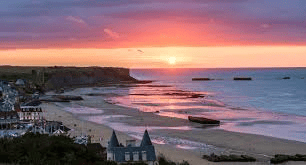
Why in News?
Several people, including a child, died trying to cross the English Channel from France to England, the French Interior Minister said recently.
About English Channel:
- The English Channel is a narrow section of the Atlantic Ocean.
- It serves as a natural boundary between the southern coast of England (part of Great Britain) and the northern coast of France.
- The channel connects to the North Sea through the Strait of Dover situated in the east.
- The term "English Channel" has been in use since the 18th century; prior to that, the English commonly referred to it as the "Narrow Sea."
- In French, it is known as "la Manche," which translates to "the Sleeve," reflecting its elongated shape.
Geographical Characteristics:
- It spans an area of approximately 29,000 square miles (75,000 square kilometers), making it the smallest shallow sea over the continental shelf of Europe.
- The channel stretches about 350 miles (560 kilometers) in length.
- At its widest point, the English Channel measures 150 miles (240 kilometers) across, while its narrowest point is just 21 miles (34 kilometers).
- It is characterized by shallow waters, with an average depth of 63 meters.
Climate:
- The region experiences a temperate maritime climate, characterized by warm summers and cold winters.
Main Islands:
- The Isle of Wight and the Channel Islands are the primary islands located within the English Channel.
- The Channel Islands include Jersey, Guernsey, Alderney, and Sark.
Significance:
- The English Channel is one of the busiest shipping regions in the world, forming a crucial link between southern England (the United Kingdom) and northern France.
- It plays a vital role in global maritime trade, accounting for up to 20% of it, and serves as a connector between the Atlantic Ocean and the North Sea.
GS3/Environment
Kawal Tiger Reserve
Source: Deccan Chronicle
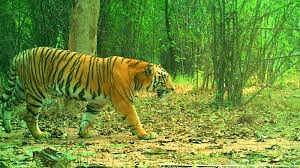
Why in news?
The forest department recently organized its inaugural 'Cyclothon' to commemorate World Wildlife Week 2024 within the buffer zone of the Kawal Tiger Reserve.
About Kawal Tiger Reserve:
- Kawal Tiger Reserve is situated in the northeastern region of Telangana State, along the banks of the Godavari River, and is part of the Deccan Peninsula-central highlands.
- It covers an area of over 2015 square kilometers and is located within the Sahyadri Mountain Ranges.
- In 2012, the Government of India designated Kawal Wildlife Sanctuary as a Tiger Reserve.
- The reserve features a variety of habitats, including dense forests, grasslands, open areas, rivers, streams, and water bodies.
- The reserve serves as the catchment area for the Godavari and Kadam rivers, which flow south of the sanctuary.
- Geographically, it lies at the southernmost point of the Central Indian Tiger Landscape, connecting with the Tadoba-Andhari Tiger Reserve in Maharashtra and Indravati Tiger Reserve in Chhattisgarh.
Vegetation:
- The primary vegetation type in the reserve is Southern Tropical Dry Deciduous Forest.
- Teak trees are abundant, accompanied by various species of bamboo.
Fauna:
- The reserve hosts a diverse array of wildlife, including:
- Cheetal (Spotted Deer)
- Sambar (Large Deer)
- Barking Deer
- Nilgai (Blue Bull)
- Sloth Bear
- Indian Bison (Gaur)
- Panther
- Tiger
- Additionally, the reserve is home to various reptiles, such as:
- Crocodile
- Python
- Monitor Lizard
- Star Tortoise
- Cobra
GS1/History & Culture
Dravidian Style of Architecture
Source: The Print

Why in news?
The Archaeological Survey of India (ASI) has recently completed the transcription of inscriptions found at three temples located in Thirukurungudi, situated in the Tirunelveli district of Tamil Nadu.
About the 3 temples mentioned:
- Nambi Rayar Temple (Thirukoshtiyur Temple)
- This temple is dedicated to Lord Vishnu and is situated near Sivaganga in Tamil Nadu.
- It is recognized as one of the 108 Divya Desams, which are sacred temples dedicated to Vishnu.
- The temple is notable for its association with Ramanuja, a pivotal figure in Vaishnavism, who learned the sacred mantra "Ashtakshara" here.
- Features a five-tiered rajagopuram (temple tower) and is constructed in the Dravidian architectural style.
- Thirumalai Nambi Temple (Thirumaliruncholai Temple)
- Also known as Azhagar Kovil, located in Madurai, Tamil Nadu.
- This temple is another one of the 108 Divya Desams.
- The temple is intricately associated with a saint and scholar who served as a priest here.
- Set in a hilly region, it features intricate carvings and sculptures characteristic of traditional Dravidian architecture.
- Aniliswarar Temple
- A Shaivite temple located in Anilivandhan Kottai, near Kanchipuram.
- This temple showcases traditional architecture with a smaller gopuram compared to larger, more famous temples.
About Dravidian Style of Architecture
- Details
- Flourished from the 8th century to the 13th-14th century AD.
- Temples are typically enclosed within a compound wall, which distinguishes them from Nagara temples.
- Notable Features
- Gopuram (Entrance Gateway): An elaborate gateway tower that serves as the main entrance to the temple complex.
- Vimana (Main Tower): A stepped pyramid-like structure that rises geometrically, differing from the curving shikhara found in North Indian temples.
- Temple Tank: Often includes a large water reservoir or temple tank within the temple complex.
- Shapes of Temples
- Square (Kuta or Caturasra)
- Rectangular (Shala or Ayatasra)
- Elliptical (Gaja-prishta or Vrittayata)
- Circular (Vritta)
- Octagonal (Ashtasra)
- Notable Temples
- The Pallavas, who were among the early builders of Dravidian temples, began with rock-cut temples before transitioning to structural temples.
- Mahabalipuram: Initiated by Narasimhavarman I (Mamalla) and completed by Narasimhavarman II (Rajasimha), featuring the Shore Temple with three shrines dedicated to Shiva.
- Rajarajeswara or Brahadeeshwarar Temple: Located in Thanjavur, built by Rajaraja Chola in 1009 CE, it is the largest and tallest of Indian temples, renowned for its large gopurams adorned with elaborate sculptures.
- Significance
- Temples served not only as religious centers but also as vital administrative hubs that managed extensive land and resources, particularly during the 8th to 12th centuries.
GS2/International Relations
Visit of President of Maldives to India
Source: Indian Express
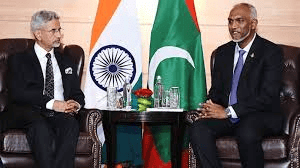
Why in news?
President of Maldives, Mohamed Muizzu, has made a State visit to India, marking his first bilateral engagement as President. Previously, he attended the swearing-in ceremony of India's Prime Minister and the Council of Ministers in June 2024. The Maldives is a significant maritime neighbor of India in the Indian Ocean Region (IOR), aligned with India's 'SAGAR' (Security and Growth for All in the Region) initiative and 'Neighbourhood First Policy.'
Significance of Maldives for India
- Location: The Maldives is strategically located just 70 nautical miles from Minicoy and 300 nautical miles from India's western coast.
- Commercial Hub: It sits at a vital intersection of maritime routes in the Indian Ocean, particularly crucial channels.
- Potential Naval Presence: The location raises concerns about the potential for third-nation naval forces operating in the region.
- Geopolitical Interests: India aims to secure sea lanes, combat piracy, and establish a peaceful Indian Ocean environment.
- Economic Opportunities: The Maldives offers prospects for blue economy initiatives and enhanced trade relations.
India – Maldives Bilateral Relation
Historical Context
- Recognition: India was among the first countries to recognize Maldives after its independence in 1965.
- Diplomatic Ties: Strong diplomatic relations were established, with India acting as a first responder in times of crisis.
Emergency Support
- Operation Cactus: In 1988, India intervened to support Maldives against a coup attempt.
- Tsunami Aid: India was the first to aid the Maldives during the 2004 Tsunami.
- COVID-19 Response: During the pandemic, India provided significant medical assistance, reinforcing its role as a primary ally.
Security & Defence Cooperation
- Defence Action Plan: An Action Plan was signed in April 2016 to enhance defence ties.
- Training Support: India meets around 70% of the training needs for the Maldivian National Defence Force (MNDF).
- Defence Dialogue: Annual dialogues at the level of Defence Secretary have been established since July 2016.
Development Cooperation
- Major Projects: Key initiatives include the Indira Gandhi Memorial Hospital and the Maldives Institute of Technical Education.
- Infrastructure Development: Projects under a $800 million Exim Bank Line of Credit focus on water and sanitation across 34 islands, roads in Addu, and a cancer hospital.
- Connectivity Initiatives: The Greater Male Connectivity Project aims to enhance transport links between islands.
Bilateral Economic and Trade Relations
- Trade Growth: India became the second-largest trade partner in 2022 and the largest in 2023.
- Financial Assistance: India provided $100 million in aid amid economic challenges in the Maldives.
- Currency Swap Agreement: An agreement signed in December 2022 allows the Maldives to draw up to $200 million from the Reserve Bank of India.
- Tourism: In 2023, Indians represented the largest group of tourists visiting the Maldives.
Indian Community
- Expatriate Population: Indians form the second-largest expatriate group in the Maldives, with approximately 22,000 individuals.
- Professionals: A significant portion of medical professionals and educators in the Maldives are of Indian origin.
|
38 videos|5293 docs|1118 tests
|
FAQs on UPSC Daily Current Affairs: 7th October 2024 - Current Affairs & Hindu Analysis: Daily, Weekly & Monthly
| 1. What is Respiratory Syncytial Virus (RSV) and why is it significant? |  |
| 2. How can Eco-Sensitive Zones (ESZ) contribute to wildlife conservation? |  |
| 3. What is Progeria and what are its main symptoms? |  |
| 4. What role does the English Channel play in global trade? |  |
| 5. How has globalization affected the nature of international trade? |  |
















